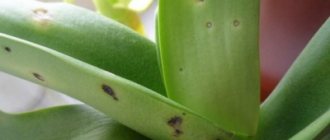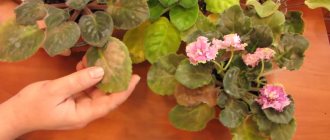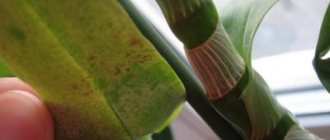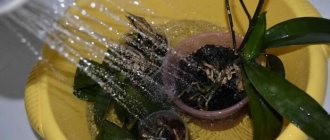Violets are very sensitive to various changes in conditions of detention, as well as to diseases. The leaves are the first to signal problems; they may turn black, wither, dry out or rot, but each symptom has its own problem.
When the leaves turn black around the edges or become covered with black spots, this
can be a sign of various problems .
It is important not only to notice the symptom in time, but also to correctly determine the cause, and only then correctly treat the violet. For various reasons, violet leaves may darken.
If treatment is applied incorrectly, it may not only not help, but also cause harm . Also, the lack of treatment leads to complications of problems that can cause the death of the individual.
Why do violet leaves turn black around the edges: the main reasons for the deterioration in the appearance of the rosette
The homeland of indoor violets is East Africa; the plants are very sensitive to cold and react sharply to even a short-term drop in temperature. Excessive humidity and soil acidification are the main factors deteriorating the condition of the outlet. If spots appear on it, it means that the rules of agricultural technology are being violated. There may be several reasons why violet leaves turn black around the edges. It is important to eliminate them in a timely manner and save the delicate plant.
Tips for preventing Saintpaulia from drying out
- Leaves that dry out are removed. When pests or diseases are found on the surface of a leaf, it is cut off and destroyed.
- White spots found on the leaf indicate that the flower has suffered cold. The plant should not touch cold glass in winter.
- The blackening of the edges or surface of the sheet plate is affected by the humidity in the room. Both low and high have a negative impact on the condition of the entire flower.
- Sudden changes in temperature in the room should not be allowed.
- Water for irrigation is taken filtered or settled, at room temperature.
- The substrate should not have a dense structure. The soil is taken either special for violets, or perlite, sphagnum or peat are added to the soil prepared independently for loosening.
Why do violets' leaves dry out? Due to failure to comply with agricultural technology rules. There are few rules, but the condition of your flower depends on its implementation.
What causes spots on leaves?
Flower growers know how demanding violets are to care for. Sissies cannot tolerate dry air, bright light, drafts or frequent watering. Any violations of the recommended agrotechnical care rules lead to a deterioration in the condition of the flower. Violet needs a balanced diet; with a lack of nitrogen and potassium, the plant begins to wither. To help him, it is necessary to understand the cause of the disease.
Sunburn
Saintpaulias standing on a windowsill are susceptible to burns. Due to direct sunlight, dry, brownish spots appear on their leaves. Plants need protection; you should hang a curtain or blinds on the window or choose another place to grow flowers. Dried leaves will not recover; they are removed. Lack of lighting also leads to problems with leaves. The short period of natural light must be supplemented by installing a lamp.
Frostbite and draft
A few seconds in the cold air when ventilating the room in the cold season is detrimental to Saintpaulia. Their leaf blades begin to darken at the edges. Gradually the spots spread over the entire surface. The flower does not require treatment; you can remove the leaves and wait for the rosette to be restored due to new growth. A draft at any temperature will cause light or brown spots to appear on the leaves.
Advice. Protect Saintpaulia from temperature changes.
Overmoistening
Excessive moisture is the main reason why violet leaves turn black around the edges. If the damaged areas are dark and soft to the touch, the flower is filled with water. Stop watering temporarily and let the soil dry out. In the future, moisten the plant only after the top layer of soil has dried. If the condition of Saintpaulia does not improve, it is necessary to inspect the root system. Perhaps a large number of roots have rotted. The flower is removed from the pot and the soil is removed. Diseased roots are cut off and the plant is transplanted into new soil. It is recommended to remove peduncles and stepsons, this will make it easier for the violet to adapt to a new location.
Stains may appear when water drops on the socket. Moisture causes the hairs on the leaves to rot and a brown area appears. Cold water is especially dangerous for violets. For irrigation, settled warm liquid is used.
Priming
For normal development, violets need light, loose soil that allows air to pass through well. Over time, the soil sags and becomes denser. The roots do not receive enough oxygen and begin to rot. The process accelerates under waterlogged conditions. With dense soil, even moderate watering becomes a problem. The lump of earth sticks together and does not dry out.
Brown spots appear on violet leaves due to lack of nutrition. There are no minerals left in the soil that the plant needs. Feeding with potassium fertilizer can correct the situation. If the flower has not been replanted for a long time, then salts have accumulated in the soil, interfering with the absorption of nutrients. In this case, the only correct solution is a transplant. The new pot should not be larger; the optimal ratio is the diameter of the container is 1/3 of the diameter of the outlet.
Attention. Don’t forget to add perlite to the soil, add drainage to the bottom of the pot, and drain the water from the pan after watering.
Causes of diseases in violets
Experienced gardeners know that it is possible to protect a plant from diseases by providing it with optimal conditions that are close to natural. It is necessary to organize proper care at home.
Violets are heat-loving plants, they feel good at temperatures of +20...+25°C, and do not tolerate drafts and temperature changes. In a cold room, violets stop growing, and frequent watering under such conditions leads to rotting of the stem and roots. Heat also has a bad effect on the flower, weakening it, which leads to illness in indoor violets.
When exposed to direct sunlight, the tender leaves of the plant get burned, wither and turn yellow. Therefore, the light in the room should be diffused and dim.
The soil must be free from pathogenic microbes and pests, so you should not take soil for violets from the garden. The soil for violets should be nutritious and light, providing air access to the roots and the drainage of excess moisture. Heavy, dense soil mixtures are not suitable for the Saintpaulia root system, causing it to rot.
Violet likes moderate moisture rather than heavy watering; it should not be moistened with cold water. To provide the guest from the tropics with optimal air humidity, the pot with the plant is placed in trays with moistened gravel or moss, or the air is freshened with a sprayer.
Dangerous pests
Diseases and pests of violets cause great damage to flower growers:
- mealybug;
- mites;
- scale insects;
- nematodes;
- thrips;
- aphid.
Insects can be brought in with garden soil, purchased plants, and cut flowers. Therefore, plants need to be inspected regularly, and if questions arise about why spots and other symptoms of the disease appear on violet leaves, treatment should be started immediately.
Ticks feed on the juice of violet leaves; their presence is indicated by the following signs:
- thin cobwebs on flowers or leaves that turn brown over time, dry out and fall off (spider mites);
- young leaves in the center of the rosette turn yellow and thicken (cyclamen mite);
- the leaves of the plant curl inward, subsequently they wither and fall off, the plant may die (plate mite).
To combat ticks, acaricides are used - Apollo, Neoron, Fitoverm.
Scale insects and false scale insects look like tubercles on the underside of the leaf, having a brown, green or yellow color. Attaching to the leaf along its veins, insects suck out the juices from the plant and produce a sticky secretion on which the sooty fungus multiplies well.
Adults must be removed from plants mechanically by soaking a swab in a soap solution, since they are not susceptible to chemicals. After removing them, the violet bush must be treated with solutions of Aktara, Bankol, Mospilan or other insecticides. The window sill, shelf, and window glass, which may contain scale insect larvae, should be treated with insecticides.
Thrips are small insects that look like elongated flies. They infect plants not only by feeding on their sap, but also by transmitting various flower diseases. Thrips are black, brown or gray in color and settle on the lower part of the leaves. After a while, you can see light dots and stripes on the top, then the leaves become deformed and fall off, the flowers crumble.
In the fight against thrips, insecticides such as Fitoverm, Actellik, Confidor are used, which are applied at the root and used for spraying. Violet leaves should be washed thoroughly before processing. If thrips were noticed on one plant, then you need to treat all the specimens in the house, because thrips migrate quickly and infect flowers.
Nematodes are small, up to 2 mm, worms that live in the ground and feed on plant roots. Signs of root infection by nematodes:
- roots are brown, black;
- the stem of the plant is elongated and thickened;
- the petioles of the lower leaves are short, the upper leaves have none;
- the leaves are compacted and dark green, curling inward;
- roots are brown, dark in color with thickenings (galls).
There are no effective means of destroying worms, so to prevent infection, peat or crushed dried marigold flowers are added to the soil. You can use an infusion of marigolds or peat to water violets.
The mealybug, or hairy louse, is visible on the plant with the naked eye. By sucking juice from shoots, leaves, and buds, parasites slow down the development and growth of the plant. The insect can be distinguished by its characteristic whitish waxy coating. A white coating similar to cotton wool is visible on the plants, on which sooty fungus multiplies.
If the plant is only slightly affected, then use a cotton swab soaked in soapy water to clean it from insects and their sticky secretions. You need to prepare a solution of green soap (15 g per 1 liter of water), spray the violets, then re-treat them 2 more times after 7-14 days.
Aphids suck sap from plant leaves, slowing their growth and inhibiting flowering. Aphid colonies are clearly visible; they prefer to settle on the underside of leaves. The danger of aphids is that they carry viral diseases, further infecting a weakened plant. To combat aphids at the very beginning of infection, it is enough to remove the damaged parts of the violet and wash it with warm soapy water.
Spots as symptoms of disease
To exclude or confirm concerns about the appearance of diseases and pests on the violet, it is necessary to carefully examine the leaves. It is recommended to use a magnifying glass. This will help you see the microscopic mites. If brown, gray or white spots appear on the leaves of your violet, it could be a fungus. Late blight, powdery mildew and gray mold are types of fungal infections that affect Saintpaulias. The occurrence of diseases is promoted by hypothermia, excess moisture, and weakened immunity. Treatment depends on the type of fungus; the affected flower must be isolated from the rest of the collection.
The cause of the spots can be determined by analyzing the agricultural technology used. First of all, the structure of the soil, the degree of its moisture and the condition of the root system are determined. It is also worth paying attention to the climatic conditions of detention. High temperatures from +30-32°C lead to overheating of the soil and damage to the socket. Don't forget to feed the flower once every two weeks. If you quickly fix the problem, the violet will soon recover. In difficult cases, the variety is preserved by rooting the leaf or cutting off the top.
Brown spots on the leaves and flowers of indoor violets - what are they?
The leaves of indoor violet are fleshy, juicy, pubescent and in a healthy state, rich green in color, elastic. If dry or weeping spots appear on the surface, it means that the structure of the fabric has changed in this place and it begins to rot or dry out. Depending on the cause, the color of the spots can be different, for example, when there is excess moisture and from a draft, they are yellow, light brown, when damaged by a fungus - dark, light gray, when damaged by insects - black, brown.
At the site where the stain appears, the supply of oxygen, nutrients, and moisture to the tissue is disrupted. This happens as a result of insect bites, activation of the infectious agent, and mechanical damage during care. The tissue in this place dies.
Why violet leaves turn black: treating the disease and eliminating other houseplant problems
Violet is a very beautiful indoor flower. But sometimes flower growers are faced with problems such as deformation of leaves, the appearance of spots on them, lack of flowering and other troubles. As a rule, this may be caused by pests or diseases of violets that have settled on the flower. Today we will talk about the signs of a plant disease, the reasons for its occurrence and what the treatment should be.
Indoor violets have brown spots on leaves and flowers: reasons, what to do and how to treat
The heat-loving Uzambara violet, also known as Saintpaulia, due to its characteristics, is demanding in terms of maintenance conditions and care, so any violations affect its condition and affect its appearance.
The appearance of any spots indicates illness, pest damage, or serious violations in care. Before starting treatment, you need to understand the cause of this condition and eliminate it - otherwise you should not expect a positive result. Timely prevention will help to avoid the disease.
Errors in care
Leaves of flowers often turn yellow. Why does this happen, and what should be the treatment? In this case, it is pointless to treat them with chemicals, since this is caused by improper care. Most often, yellowing of leaves is caused by a lack of lighting, moisture or a deficiency of nutrients in the soil. Therefore, in order for your pet to be healthy and beautiful, you need to provide her with proper care.
Signs of infectious diseases
The appearance of an infectious disease is primarily indicated by the appearance of the flower; it becomes sluggish, its leaves fade and become smaller. Such signs usually indicate the appearance of the following diseases:
Powdery mildew
The main sign of its appearance is a gray coating on the violet leaves. Why does the disease appear and how to treat it? This disease most often appears with a lack of lighting, low temperature and high humidity. Quite often, the cause of powdery mildew is an excess of nutrients in the soil.
To save a flower, you need to spray it with Fundazol or Benlat. Many people ask the question, is it possible to spray violets? We answer, it is possible and even necessary, otherwise it will not be possible to save the plants. As a preventative measure, it is necessary to regularly wipe the leaves of the flower and periodically ventilate the room.
Disease Prevention
The best method of combating plant diseases is prevention. To prevent violet diseases, you must follow some rules:
- When purchasing a flower, it is recommended to isolate it from other indoor plants for the adaptation period, as it may be diseased.
- Inspect the flower regularly. When the first signs of disease appear, be sure to isolate the plant and begin treatment.
- Be sure to treat the soil with fungicides before planting, this will help prevent diseases of violets.
Follow these simple rules, and your indoor beauty will delight your eyes with its beauty, abundant and long-lasting flowering.
The main question: why do violet leaves darken?
Violets are very sensitive to various changes in living conditions, as well as to diseases.
The leaves are the first to signal problems; they may turn black, wither, dry out or rot, but each symptom has its own problem. For various reasons, violet leaves may darken.
If treatment is applied incorrectly, it may not only not help, but also cause harm . Also, the lack of treatment leads to complications of problems that can cause the death of the individual.
Brown spots on violet leaves: why and what to do?
There are various reasons why brown spots appear on leaves.
For various reasons, brown spots may appear on viola leaves.
Their early detection will help maintain the health of your favorite flower.
Causes of the disease
Why do brown spots appear on purple leaves? The appearance of brown spots on purple leaves may be due to:
- As in care failure;
- It's the same with flower disease.
Improper care
Not many people know why leaves turn brown. At the first signs of spotting, it is necessary to analyze the condition of the plant:
- When exposed to direct sunlight for a long time in summer, burns appear on the leaves, which turn brown over time. The burnt leaves are removed and the flower is moved to another place or shaded by a window;
- The edge of the leaf often turns brown at the beginning of the heating season due to a significant decrease in air humidity. The lower leaves of such a plant are removed and the watering regime is normalized;
- The appearance of spots is provoked by irrigation with cold water. To prevent this from happening, the water for irrigation should be at room temperature;
- Irregular yellow or silver-brown spots often appear when exposed to drafts during winter ventilation or when the ambient temperature suddenly drops below 16 ℃. The same effect is caused by contact of fabric with a cold window in winter;
- Often brown spots on the lower leaves indicate alkalization of the soil. In an alkaline environment, some nutrients are poorly soluble in water and are not absorbed by the roots. Such a plant needs to be replanted and completely replace the soil.
Important! Depending on the cause of the appearance of spots on the leaves, the flower is transplanted onto a new substrate or the conditions of its maintenance are adjusted.
Fungal diseases
The appearance of brown spots on purple leaves is often the result of a microbial infection. Therefore, the leaves were covered with brown spots.
Fungal diseases can cause brown or purple spots.
Attention! Excessive watering of violets against the backdrop of low growing temperatures and high humidity are ideal conditions for the development of fungal and bacterial diseases.
Fusarium
What to do if fusarium appears on viola?
Fusarium is a root disease of violets.
A fungal disease that manifests itself as wilting, perforation and subsequent death of leaves, darkening of the roots. Treatment is usually ineffective and the alt dies.
Gray rot
Why did the leaves turn brown? The mycelium of the fungus grows in the area of the rosette and therefore spreads throughout the plant:
- The stem and leaves are covered with small brown spots;
- The tips of the leaf blade turn brown;
- Flowers and buds are covered with mold.
Areas affected by gray rot die off.
Brown rot
The fungus affects:
- Root;
- And he leaves.
They take on a brownish-brown color and over time the tissue softens and dies. On the ground below the exit, whitish threads of mycelium are visible.
Late blight
A fungal disease of violets that is practically untreatable:
- The first stage of the disease looks like a lack of water for the plant, but after watering the flower does not recover and withers even more;
- The disease then spreads to the roots and root collar, stem and leaves.
Downy mildew in violets is difficult to cure.
Important! Affected tissues turn brown and die.
Bacterial lesions
Bacterial spots differ from spots of fungal origin in the absence of spore-forming pustules.
Bacterial burn
Why do brown spots appear on the leaves - what are they? It could be a bacterial burn. Bacteria of the genus Pseudomonas cause diseases:
- In this case, the edge of the leaf looks burnt, and over time the disease covers the entire plant;
- The blackened area is shapeless.
This allows you to distinguish fire blight from fire blight.
Bacterial spot
What caused leaf rust: cause and treatment? At the initial stage, the disease manifests itself as small watery spots that gradually change color, becoming brown and black.
They are often surrounded by a yellow or light green border. As the spots grow, the plant weakens and dies.
Pests
Insect pests pose a great danger to violets. Insects can appear not only on leaves, but also on flowers.
Cyclamen mite
It affects the growing point of the viola; if it is present, the flowers become smaller, the leaves:
- They are deformed;
- And they fall.
Spider mite
Small brown spots appear on the foliage, as if the surface of the leaf was pierced with a needle.
Spider mites are very small and difficult to see in purple.
Nematode
Lives on roots, feeding on plant sap:
- In the initial stage of the disease, the parasite is not detected;
- Subsequently, the leaves become covered with light green spots, which causes brown spots and rot;
- You can make a diagnosis by examining the root system when transplanting a flower.
Nematodes attack the root system of violets.
Important! It is impossible to get rid of nematodes, so the infected flower is destroyed.
Why do violet leaves darken?
If your violet appears blackened on the leaves, on the tips, or in spots, the first thing you need to do is determine the cause. Among them, only two main directions :
- Errors in care;
- Fungal diseases.
Each of the reasons consists of factors that can be included in it, and knowing them you can :
- Determine the direction of treatment;
- Or bug fixes.
Each of them leads to its own consequences, which together can lead to blackening of the leaves.
Errors in content
One of the most common problems. Caring for violets is a rather complicated process, and many novice gardeners make mistakes. Possible errors are made in the following areas :
Stains only form if :
- Sunburn;
- And spot frostbite.
In all cases of improper care, the symptoms cannot indicate a specific cause, and here it is important to completely review all the factors and find the error.
Violet leaves may darken due to improper care.
Nuances that lead to blackening of leaves:
- Improper watering:
- Hard water - if you use unsettled water, there is a risk of salts settling in the soil and blackening of the leaves;
- Cold water - the root system of violets is very afraid of hypothermia, so even water that has cooled in the pan in cold weather can cause problems;
- Excessive watering - too much water is also bad. The consequence is rotting of the roots, and one of the symptoms may be blackening of the leaves.
- Packed soil . If transplantation is not carried out often enough, the substrate stagnates, becomes salty and clumps together. The roots cannot breathe, and the salts that accumulate lead to root disease. Blackening of leaves is a possible symptom of this problem;
- Wrong place for the flowerpot . Direct sunlight and drafts are factors whose likelihood must be excluded when choosing a place for a flower;
- Temperature and humidity . If it is cold on the windowsill, then it is better not to place a flowerpot there; in winter, standing close to the window glass, the plant can even get frostbite. High humidity can also lead to root rot and black spots;
- Lack of useful elements in the soil . The earthen ball becomes depleted over time and, if fertilizers are not applied on time, this depletion can be critical and lead to problems;
- Overfeeding with fertilizers . A lot, as well as a little, is bad if the concentration exceeds the recommended, or fertilizing is carried out too often.
The tips of the violet leaves turn black
Violets are very sensitive to various changes in living conditions, as well as to diseases. The leaves are the first to signal problems; they may turn black, wither, dry out or rot, but each symptom has its own problem.
For various reasons, violet leaves may darken.
If treatment is applied incorrectly, it may not only not help, but also cause harm . Also, the lack of treatment leads to complications of problems that can cause the death of the individual.
Why do violet leaves darken?
If your violet appears blackened on the leaves, on the tips, or in spots, the first thing you need to do is determine the cause. Among them, only two main directions :
- Errors in care;
- Fungal diseases.
Each of the reasons consists of factors that can be included in it, and knowing them you can :
- Determine the direction of treatment;
- Or bug fixes.
Each of them leads to its own consequences, which together can lead to blackening of the leaves.
Errors in content
One of the most common problems. Caring for violets is a rather complicated process, and many novice gardeners make mistakes. Possible errors are made in the following areas :
Stains only form if :
- Sunburn;
- And spot frostbite.
In all cases of improper care, the symptoms cannot indicate a specific cause, and here it is important to completely review all the factors and find the error.
Violet leaves may darken due to improper care.
Nuances that lead to blackening of leaves:
- Improper watering:
- Hard water - if you use unsettled water, there is a risk of salts settling in the soil and blackening of the leaves;
- Cold water - the root system of violets is very afraid of hypothermia, so even water that has cooled in the pan in cold weather can cause problems;
- Excessive watering - too much water is also bad.
The consequence is rotting of the roots, and one of the symptoms may be blackening of the leaves. - Packed soil .
If transplantation is not carried out often enough, the substrate stagnates, becomes salty and clumps together. The roots cannot breathe, and the salts that accumulate lead to root disease. Blackening of leaves is a possible symptom of this problem; - Wrong place for the flowerpot . Direct sunlight and drafts are factors whose likelihood must be excluded when choosing a place for a flower;
- Temperature and humidity .
If it is cold on the windowsill, then it is better not to place a flowerpot there; in winter, standing close to the window glass, the plant can even get frostbite. High humidity can also lead to root rot and black spots; - Lack of useful elements in the soil .
The earthen ball becomes depleted over time and, if fertilizers are not applied on time, this depletion can be critical and lead to problems; - Overfeeding with fertilizers . A lot, as well as a little, is bad if the concentration exceeds the recommended, or fertilizing is carried out too often.
Most often, leaves turn black in winter due to frostbite, and in summer due to direct sunlight.
Infectious diseases
Among all infections, only late blight can have . This fungus infects violets through damaged areas of leaves and roots. Spots on an infected flower spread to the leaves and even flowers and have a brownish-black tint. Therefore, the violet leaves darkened and stopped growing and developing.
Violet leaves may darken due to fungal diseases.
When the edges of the leaves turn black, the violet can still be saved.
Dense, compacted soil
Substrate, and mistakes made when choosing and using it can lead to unpleasant consequences . If the soil was initially chosen incorrectly, the consequences are unlikely to be blackening on the leaves. But improper use can lead to this.
It is important to change the soil in the pot at least once every two years , and preferably once or twice a year. If the substrate is left for a long time, it absorbs salts, and they interfere with a full existence. Also, useful substances from the soil are depleted, and their deficiency leads to blackening of the tips.
Source: https://ogorod.guru/ogorod/u-fialki-chernejut-konchiki-listev.html
Recovery after improper care
The violet leaves are turning black, what should I do? After determining the cause - problems in care, it is important to eliminate mistakes made earlier:
- When the problem is watering, procedures and preventive actions are carried out:
- If necessary, the affected leaves are removed; usually, even after treatment, they gradually die off, and all this time they simply draw strength and juices from the violet;
- If the soil is waterlogged, replace it and give the roots a day without additional watering. This is necessary to dry out and prevent possible root rot;
- For subsequent irrigations, only settled and warm water is used. It is also important not to over-water the transplanted plant.
- If the problem is in old or incorrect soil, it is replaced , and then the general rules of care are followed. As in the first option, it is better to remove leaves affected by blackness;
- You need to provide the right place and conditions . There should be a lot of light, but without direct sunlight. Temperature within 16-25°, and constant humidity. Humidity is provided using humidifiers, or wet expanded clay under the pots;
- Ensure the correct dosage of nutrients . Feeding is carried out once every two weeks in the summer, and once a month in the winter. The concentration is made two times less than recommended in the instructions.
With proper care, violet leaves will feel great.
Reason 1 – improper watering
The most common reason for the appearance of black spots on violet leaves is improper watering. Moreover, overwatering is more destructive for these delicate plants than underwatering. An overdried violet can still be saved (tear off all the dried leaves and water the plant), but a flooded violet often cannot.
To begin with, if you have a “swamp” in the pot, stop watering until the earthen ball dries completely. Then touch the darkened leaves. If they become soft, the roots may have already begun to rot. In this case, the plant will need to be replanted. Remove it from the pot, remove all damaged roots of the plant (rotten), and treat the wounds with any disinfectant, such as crushed activated carbon or ash. Transplant the violet into another pot. Choose a soil that is designed specifically for violets: it is light and loose, with any leavening agent (perlite, coarse sand, etc.). After transplanting, water the plant with Fitosporin solution.
What to do?
In the future, do not forget how to water violets correctly:
- Watering is carried out only after the earthen clod has completely dried. Sometimes it is difficult to determine whether the soil is completely dry or whether the soil closer to the bottom of the pot is still wet. In this case, you can take a stick and pierce the soil with it. However, be careful not to damage the plant's roots;
- You can water violets only with settled water, the temperature of which is several degrees higher than room temperature (but not higher than 30°C);
- It is better to water the violet using the wick method or in a tray (excess water after watering should be poured out of the tray immediately). If you water from above, be sure to use a watering can without a sprayer and pour directly under the root.
How to understand that the violet is flooded?
When the soil is wet to the touch, its color is dark, and the pot has noticeable weight, it means the plant is flooded (overmoistened). If the plant is slightly wilted and you are sure that you accidentally missed it during the previous watering, simply water the violet as usual.
Interesting materials:
How to make your nails shine without polish? How to shape a bonsai tree? How to invite your friends to public? How to prepare a 3 percent solution of hydrogen peroxide from tablets? How to make lipstick at home? How to prepare a solution for bas-relief? How to prepare a solution for cementing? How to prepare burdock oil in a water bath? How to prepare window cleaner? How to cook veal so that it is soft?
Reason 2 – temperature conditions
Violet is very sensitive to ambient temperature. Both excessive cold and excessive heat are undesirable for her. If on the windowsill in winter there are constantly low temperatures that are not suitable for violets, the earthen lump (after all, the pots are small) often gets supercooled. This can lead to rotting of the roots, which will first make itself felt by the blackening of the leaves, and then by the death of the plant.
Heat, for example from batteries, and the rays of the scorching sun can cause burns on violet leaves, as a result of which the edges of the leaf blade darken.
What to do?
Change the violet's place of residence. Move it away from the battery and remove it from the window. Remember that violet prefers good lighting, but does not like direct sunlight.
As for the ambient temperature, the optimal range for violets is considered to be 16-20°C in winter and 20-25°C in summer.
Reason 3 – drafts
If you decide to ventilate the room on a winter day, then remove the plants away from the window first. Just a few minutes at a low temperature and dark circles will appear on the violet leaves. Then they will gradually spread to the entire leaf blade. The reason is a draft, which negatively affects violets. The same thing will happen in a draft in the warm season.
What to do?
Find a place for the violets where they will not be exposed to air currents. Moreover, we are talking not only about the air from the window, but also about those air jets that are created by a fan or air conditioner. Before airing, remove pots with violets from the window or cover them, for example, with polycarbonate sheets.
Violets have yellow spots on the leaves
To understand what exactly Saintpaulia says, just look carefully at its leaves.
Violet leaves become spotted for various reasons:
- One of the reasons why yellow-brown spots appear on the leaves of violets is abundant watering with hard water or deep planting . In the first case, use settled water; in the second, only replanting will help;
Such stains can appear from exposure to hard water.
You can get more information about why violets have brown spots on their leaves here.
- yellow spots on violet leaves appear after watering, when water gets on the leaf plate , the flower is placed in a draft or in the sun. Use a paper towel to blot away any moisture on the leaves;
Information about whether violet leaves have become spotted is thoroughly discussed here.
- the edges of the lower leaves turned yellow, then turned brown - necrosis . Occurs when the soil is incorrectly selected, when overflowing or drying out of the earthen coma, an imbalance in nutrition, or high temperature may occur. Only transplantation and optimization of living conditions will help;
Reason 4 – low humidity levels
Too dry air in the room can also cause black spots to appear on violet leaves. The optimal humidity level for these flowers is 50%. It is difficult to achieve in an ordinary apartment, especially after turning on the heating during the cold season.
What to do?
There are several ways to increase the humidity level in areas where violets are kept:
- Place containers of water in the room;
- place the pot of violets in a large container with wet expanded clay or pebbles;
- You can also humidify the air in the room in the following way: hang a damp cloth over the radiator, wet it as it dries.
Reason 5 – unsuitable pot
Even an unsuitable pot can cause black spots to appear on violet leaves. Moreover, here two criteria need to be considered at once: material and size.
Oddly enough, the best material for a pot of violets is not ceramic, but plastic. In a ceramic pot, the soil remains moist longer, which is not at all good for violets. In addition, water drains out of it more slowly because there is only one hole in the bottom to drain excess liquid. In a plastic pot, if such a problem exists, you can make a few more holes yourself.
The size of the pot is also important. Violets have a small shallow root system, so they do not require large pots. According to experts, the diameter of the pot should be 3 times less than the diameter of the violet bush. In a large pot, different layers of soil can be dried in different ways: the top layer is already dry, while the area around the roots is still damp. This means it’s better to hold off on watering.
What to do?
Replant the violet in a suitable sized plastic pot. Transplantation, even if the flower grows well, should be done at least once a year, or better yet, once every 6-8 months.
Reason 6 – lack of nutrients
Due to the fact that the pots for violets are small, the soil in them is depleted very quickly. In addition, salts can accumulate in it, which will prevent the roots from absorbing nutrients. In both cases, the plant experiences a deficiency of elements necessary for normal development. And the same darkening of the leaves can indicate a lack of nutrients.
What to do?
Violets need to be fed regularly. During the period of growth and active flowering, plants need regular feeding. Approximately once every two weeks you need to apply complex mineral fertilizers.
Reason 7 – fungal diseases
And the most difficult reason in terms of consequences is fungal diseases of violets. If the leaves of your violet suddenly, for no apparent reason, become covered with dark spots and begin to fade, the plant most likely has suffered from late blight. These spots look similar to others. However, with a fungal disease, darkening, as in other cases, begins not with the leaf, but with the stem and gradually spreads to the leaf and the entire plant.
What to do?
Most likely, you will have to take radical measures - part with the violet. Wash the pot in which it grew thoroughly and pour boiling water over it. Freeze the soil for the new plant and sprinkle it with Fitosporin for prevention. In the future, to avoid infection by fungal diseases, follow agricultural practices and avoid overwatering the plant.
Violet is not the easiest plant to care for. However, lovers of these flowers are ready to endure all the vagaries for the pleasure of seeing their incredibly delicate and beautiful blooms.











